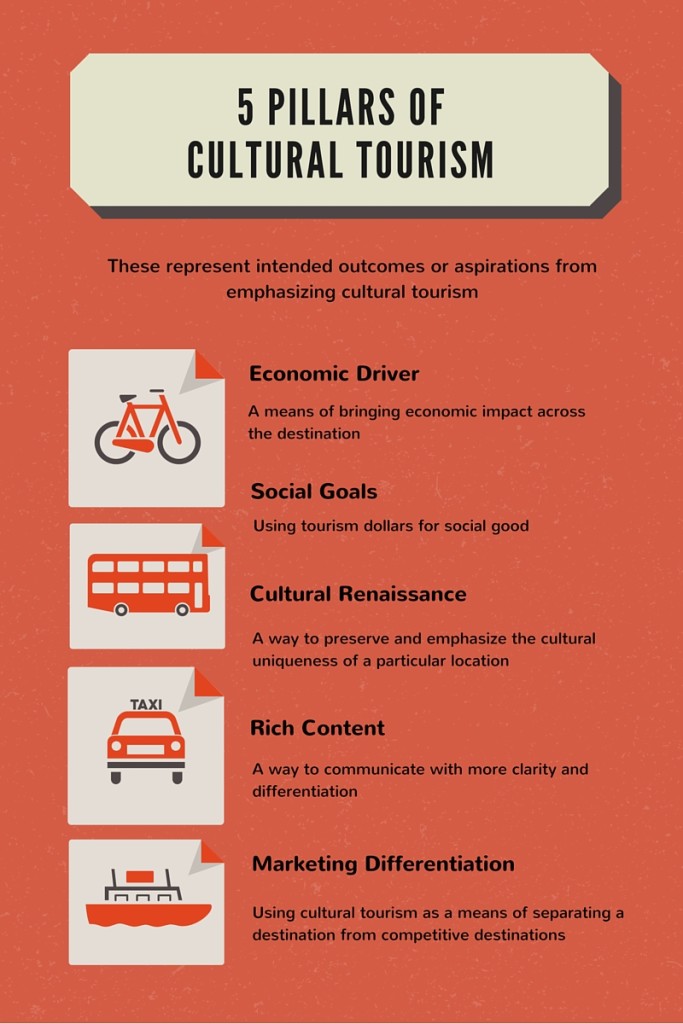By Jeff Goss, CEO
There are many exciting new trends in travel and tourism marketing to look forward to in 2016. Mobile, virtual reality, personalization, content, and so many more. Of all the predictions, the one that is most exciting and holds the greatest potential impact for destination marketing executives is the rise of Cultural Tourism.
What, exactly, is “cultural tourism?” (1) Before going too far, let us share some definitions. The World Tourism Organization defines “cultural tourism” as trips with the goal of visiting sites and events with cultural and historical value (2). Cultural tourism includes a means or opportunity to enjoy past human accomplishments. In other words, “visiting such places creates admiration, national pride and the rediscovery of the achievements of our ancestors.”
An important aspect of cultural tourism is intangible cultural heritage. This is defined as those practices, expressions, knowledge and skills that communities and individuals recognize as part of their cultural heritage (3). Transmitted through generations and constantly recreated, they provide humanity with a sense of identity and continuity.
We have identified “Five Pillars” of cultural tourism (4). For the most part, these concepts suggest intended outcomes or aspirations from emphasizing cultural tourism. Collectively, they provide further proof of the potential benefits of a focus on not just the place or its history but the indigenous and sometimes more allusive, culture.
- Economic Driver: A means of bringing economic impact across the destination, including the underserved or minority aspects of the destination;
- Social Goals: Using tourism dollars for social good;
- Cultural Renaissance: A way to preserve and emphasize the cultural uniqueness of a particular location;
- Rich Content; A way to communicate with more clarity and differentiation;
- Marketing Differentiation: Using cultural tourism as a means of separating a destination from competitive destinations.
As we help destination adopt a cultural tourism strategy, there are often natural tensions which occur with respect to intended outcomes, program management and the use of specific tourism assets. For instance, there is often a lack of understanding with respect to the potential economic impact of increased tourism and who should benefit from the incremental revenues. There are often issues associated with preservation, maintenance cost, economic exploitation, and the specific strategies used to promote cultural assets. They are all great topics of discussion and result in a much deeper understanding of the value of a cultural tourism strategy.
But despite the barriers, most civic, state and regional leaders agree that cultural tourism is an increasing trend and one that provides return on investment for its practitioners. Given the often sensitive and politicized nature of cultural heritage, it makes sense to emphasize and frequently remind stakeholders of the benefits. Not only the opportunity to broaden the appeal of a destination to fatten its coffers but to help spread the economic benefit to communities and constituents who would not be included in the traditional destination marketing approach. Cultural tourism has been very successful outside of the US and is proving to be a real differentiator here in the states.
For more information about how to put cultural tourism into your destination marketing strategy, visit www.culturaltourism.thegossagency.com/overview/.
The Goss Agency is a nationally-recognized travel and destination marketing firm with significant experience and credentials in, cultural tourism and tourism promotion. The firm has experience with a broad cross-section of destinations including tourist attractions, municipalities, counties and Native American Tribes.
Notes
- “Cultural Tourism Overview,” 2004.
- Travel Industry Association of America, 2013.
- “Study on Tourism and Intangible Cultural Heritage,” World Tourism Organization, 2011.
- UNESCO Convention of Safeguarding Cultural Heritage, 2003.

